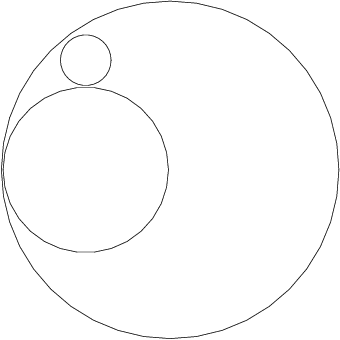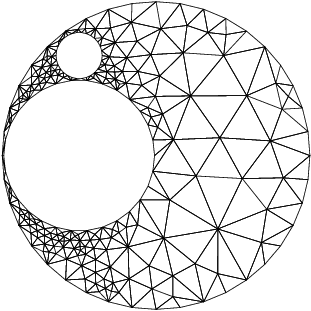nag_mesh2d_inc (d06aac) generates a triangular mesh of a closed polygonal region in , given a mesh of its boundary. It uses a simple incremental method.
nag_mesh2d_inc (d06aac) generates the set of interior vertices using a process based on a simple incremental method. A smoothing of the mesh is optionally available. For more details about the triangulation method, consult the
d06 Chapter Introduction as well as
George and Borouchaki (1998).
This function is derived from material in the MODULEF package from INRIA (Institut National de Recherche en Informatique et Automatique).
- 1:
nvb – IntegerInput
On entry: the number of vertices in the input boundary mesh.
Constraint:
.
- 2:
nvmax – IntegerInput
On entry: the maximum number of vertices in the mesh to be generated.
- 3:
nedge – IntegerInput
On entry: the number of boundary edges in the input mesh.
Constraint:
.
- 4:
edge[] – const IntegerInput
-
Note: the th element of the matrix is stored in .
On entry: the specification of the boundary edges.
and
contain the vertex numbers of the two end points of the
th boundary edge.
is a user-supplied tag for the
th boundary edge and is not used by nag_mesh2d_inc (d06aac). Note that the edge vertices are numbered from
to
nvb.
Constraint:
and , for and .
- 5:
nv – Integer *Output
On exit: the total number of vertices in the output mesh (including both boundary and interior vertices). If , no interior vertices will be generated and .
- 6:
nelt – Integer *Output
On exit: the number of triangular elements in the mesh.
- 7:
coor[] – doubleInput/Output
-
Note: the th element of the matrix is stored in .
On entry: contains the coordinate of the th input boundary mesh vertex; while contains the corresponding coordinate, for .
On exit: will contain the coordinate of the th generated interior mesh vertex; while will contain the corresponding coordinate, for . The remaining elements are unchanged.
- 8:
conn[] – IntegerOutput
-
Note: the th element of the matrix is stored in .
On exit: the connectivity of the mesh between triangles and vertices. For each triangle
,
gives the indices of its three vertices (in anticlockwise order), for
and
. Note that the mesh vertices are numbered from
to
nv.
- 9:
bspace[nvb] – const doubleInput
On entry: the desired mesh spacing (triangle diameter, which is the length of the longer edge of the triangle) near the boundary vertices.
Constraint:
, for .
- 10:
smooth – Nag_BooleanInput
On entry: indicates whether or not mesh smoothing should be performed.
If , the smoothing is performed; otherwise no smoothing is performed.
- 11:
coef – doubleInput
On entry: the coefficient in the stopping criteria for the generation of interior vertices. This argument controls the triangle density and the number of triangles generated is in
. The mesh will be finer if
coef is greater than
and
is a good value.
Suggested value:
.
- 12:
power – doubleInput
On entry: controls the rate of change of the mesh size during the generation of interior vertices. The smaller the value of
power, the faster the decrease in element size away from the boundary.
Suggested value:
.
Constraint:
.
- 13:
itrace – IntegerInput
On entry: the level of trace information required from nag_mesh2d_inc (d06aac).
- No output is generated.
- Output from the meshing solver is printed. This output contains details of the vertices and triangles generated by the process.
You are advised to set , unless you are experienced with finite element mesh generation.
- 14:
outfile – const char *Input
On entry: the name of a file to which diagnostic output will be directed. If
outfile is
NULL the diagnostic output will be directed to standard output.
- 15:
fail – NagError *Input/Output
-
The NAG error argument (see
Section 3.6 in the Essential Introduction).
- NE_ALLOC_FAIL
-
Dynamic memory allocation failed.
- NE_BAD_PARAM
-
On entry, argument had an illegal value.
- NE_INT
-
On entry, .
Constraint: .
- NE_INT_2
-
On entry, and .
Constraint: .
On entry, the endpoints of the edge have the same index : and .
- NE_INT_4
-
On entry, , , and .
Constraint: and , where denotes .
- NE_INTERNAL_ERROR
-
An internal error has occurred in this function. Check the function call and any array sizes. If the call is correct then please contact
NAG for assistance.
- NE_MESH_ERROR
-
An error has occurred during the generation of the interior mesh. Check the inputs of the boundary.
- NE_NOT_CLOSE_FILE
-
Cannot close file .
- NE_NOT_WRITE_FILE
-
Cannot open file for writing.
- NE_REAL
-
On entry, .
Constraint: .
On entry, .
Constraint: .
- NE_REAL_ARRAY_INPUT
-
On entry, and .
Constraint: .
Not applicable.
Not applicable.
The position of the internal vertices is a function of the positions of the vertices on the given boundary. A fine mesh on the boundary results in a fine mesh in the interior. The algorithm allows you to obtain a denser interior mesh by varying
nvmax,
bspace,
coef and
power. But you are advised to manipulate the last two arguments with care.
You are advised to take care to set the boundary inputs properly, especially for a boundary with multiply connected components. The orientation of the interior boundaries should be in clockwise order and opposite to that of the exterior boundary. If the boundary has only one connected component, its orientation should be anticlockwise.
In this example, a geometry with two holes (two interior circles inside an exterior one) is meshed using the simple incremental method (see the
d06 Chapter Introduction). The exterior circle is centred at the origin with a radius
, the first interior circle is centred at the point
with a radius
, and the second one is centred at the point
with a radius
. Note that the points
and
) are points of ‘near tangency’ between the exterior circle and the first and second circles.
The boundary mesh has
vertices and
edges (see
Figure 1). Note that the particular mesh generated could be sensitive to the
machine precision and therefore may differ from one implementation to another.
Figure 2 contains the output mesh.
Figure 1: The boundary mesh of the geometry with two holes
Figure 2: Interior mesh of the geometry with two holes


